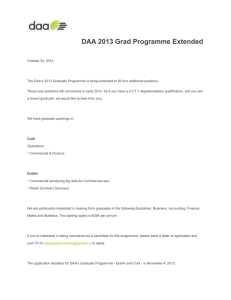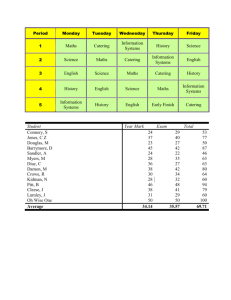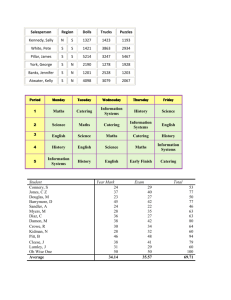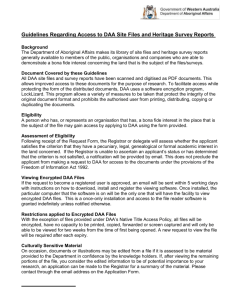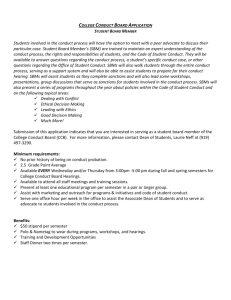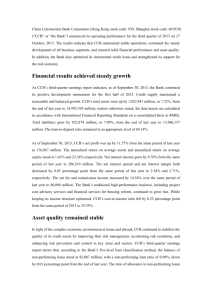Building Blocks and Excluded Sums
advertisement
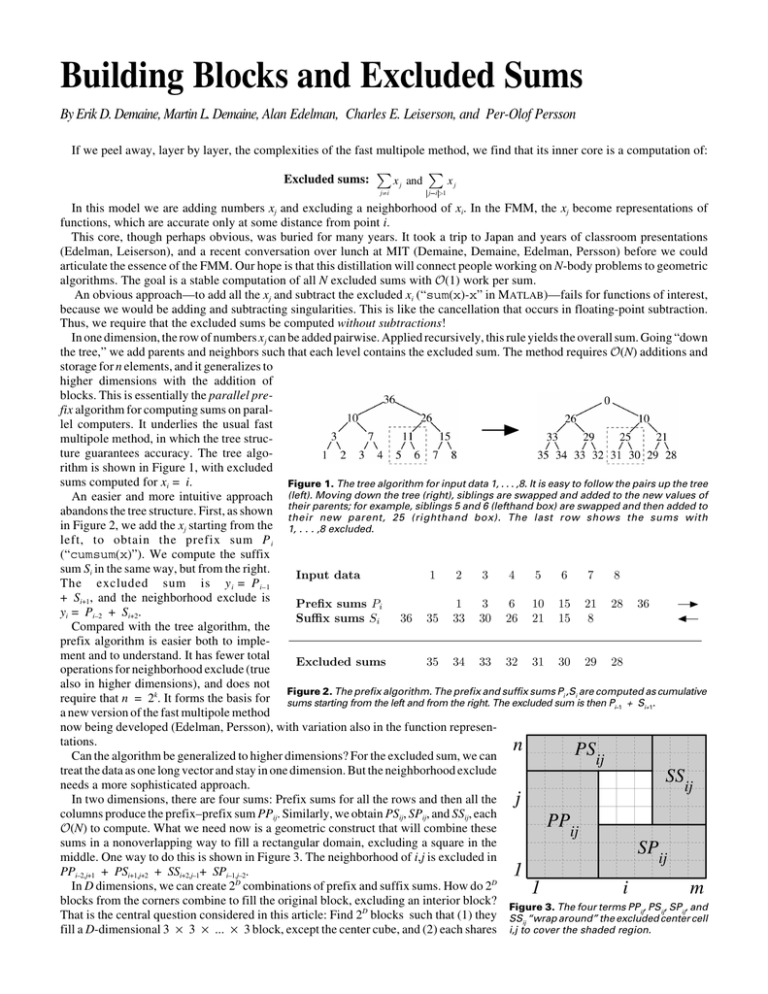
Building Blocks and Excluded Sums
By Erik D. Demaine, Martin L. Demaine, Alan Edelman, Charles E. Leiserson, and Per-Olof Persson
If we peel away, layer by layer, the complexities of the fast multipole method, we find that its inner core is a computation of:
Excluded sums:
x
v
j i
j
and
x
ji 1
j
In this model we are adding numbers xj and excluding a neighborhood of xi. In the FMM, the xj become representations of
functions, which are accurate only at some distance from point i.
This core, though perhaps obvious, was buried for many years. It took a trip to Japan and years of classroom presentations
(Edelman, Leiserson), and a recent conversation over lunch at MIT (Demaine, Demaine, Edelman, Persson) before we could
articulate the essence of the FMM. Our hope is that this distillation will connect people working on N-body problems to geometric
algorithms. The goal is a stable computation of all N excluded sums with O(1) work per sum.
An obvious approach—to add all the xj and subtract the excluded xi (“sum(x)-x” in MATLAB)—fails for functions of interest,
because we would be adding and subtracting singularities. This is like the cancellation that occurs in floating-point subtraction.
Thus, we require that the excluded sums be computed without subtractions!
In one dimension, the row of numbers xj can be added pairwise. Applied recursively, this rule yields the overall sum. Going “down
the tree,” we add parents and neighbors such that each level contains the excluded sum. The method requires O(N) additions and
storage for n elements, and it generalizes to
higher dimensions with the addition of
blocks. This is essentially the parallel prefix algorithm for computing sums on parallel computers. It underlies the usual fast
multipole method, in which the tree structure guarantees accuracy. The tree algorithm is shown in Figure 1, with excluded
sums computed for xi = i.
Figure 1. The tree algorithm for input data 1, . . . ,8. It is easy to follow the pairs up the tree
An easier and more intuitive approach (left). Moving down the tree (right), siblings are swapped and added to the new values of
their parents; for example, siblings 5 and 6 (lefthand box) are swapped and then added to
abandons the tree structure. First, as shown their
new parent, 25 (righthand box). The last row shows the sums with
in Figure 2, we add the xj starting from the 1, . . . ,8 excluded.
left, to obtain the prefix sum P i
(“cumsum(x)”). We compute the suffix
sum Si in the same way, but from the right.
The excluded sum is y i = P i–1
+ Si+1, and the neighborhood exclude is
yi = Pi–2 + Si+2.
Compared with the tree algorithm, the
prefix algorithm is easier both to implement and to understand. It has fewer total
operations for neighborhood exclude (true
also in higher dimensions), and does not
Figure 2. The prefix algorithm. The prefix and suffix sums Pi ,Si are computed as cumulative
require that n = 2k. It forms the basis for sums starting from the left and from the right. The excluded sum
is then Pi–1 + Si+1.
a new version of the fast multipole method
now being developed (Edelman, Persson), with variation also in the function representations.
Can the algorithm be generalized to higher dimensions? For the excluded sum, we can
treat the data as one long vector and stay in one dimension. But the neighborhood exclude
needs a more sophisticated approach.
In two dimensions, there are four sums: Prefix sums for all the rows and then all the
columns produce the prefix–prefix sum PPij. Similarly, we obtain PSij, SPij, and SSij, each
O(N) to compute. What we need now is a geometric construct that will combine these
sums in a nonoverlapping way to fill a rectangular domain, excluding a square in the
middle. One way to do this is shown in Figure 3. The neighborhood of i,j is excluded in
PPi–2,j+1 + PSi+1,j+2 + SSi+2,j–1+ SPi–1,j–2.
In D dimensions, we can create 2D combinations of prefix and suffix sums. How do 2D
blocks from the corners combine to fill the original block, excluding an interior block? Figure 3. The four terms PP , PS , SP , and
ij
ij
ij
That is the central question considered in this article: Find 2D blocks such that (1) they SS “wrap around” the excluded
center cell
ij
fill a D-dimensional 3 × 3 × ... × 3 block, except the center cube, and (2) each shares i,j to cover the shaded region.
1
a corner with the containing block.
Some experimentation with building blocks
produces an answer in three dimensions (see
Figure 4).
For help in moving beyond three dimensions (and understanding the higherdimensional problem) we (Edelman,
Persson) described the problem over lunch
to Erik and Martin Demaine. Shortly afterward, the e-mail exchange reproduced on
the bottom of this page took place.
Figure 4. Block configurations that exclude the center blocks in one, two, and three
dimensions.
From: edelman@math.mit.edu
|To: Erik Demaine <edemaine@mit.edu>
Date: Tue, 15 Jul 2003 12:46:57 -0400 (EDT)
Subject: Re: 3d geometry
Can you do this in arbitrary dimensions?
From: Erik Demaine <edemaine@mit.edu>
To: Alan Edelman <edelman@math.mit.edu>
Cc: Martin Demaine <mdemaine@mit.edu>
Date: Tue, 15 Jul 2003 16:52:39 -0400 (Eastern Standard Time)
Subject: Re: 3d geometry
Yes. Nice question. It led us to discover a general construction for such beasts. The construction is recursive, and behaves differently
depending on the parity of the dimension.
Lets start with 1-D. Here there are only two unfilled squares surrounding the hole:
? ?
We can assign them to boxes arbitrarily:
A B
Lets move to 2-D. We know that every one-dimensional cross-section of a 2-D solution must be an instance of the 1-D solution. Hence
we obtain the following information:
?A?
D B
?C?
There are now four letters, and each one needs to extend so that it touches a corner. There are also exactly four unmarked corners. What
is essential for this to work is that the connections between unmarked corners and singleton letters that need to be extended form a cycle.
Therefore, we can choose one orientation of the cycle, and extend each letter into the next corner along the cycle. Thus:
DAA
D B
CCB
In 3-D, again we know that every two-dimensional cross-section of a 3-D solution must be an instance of this 2-D solution. This tells us
a lot. The first cross-section tells us:
2
???
???
???
DAA
D B
CCB
???
???
???
???
DEE
???
DAA
D B
CCB
???
FFB
???
?A?
DEE
?E?
DAA
D B
CCB
?F?
FFB
?C?
The second cross-section tells us:
The third cross-section tells us:
In fact, each of these cross-sections has a binary choice about whether it is clockwise or counterclockwise, but it does not matter which
we choose. Every letter used so far has been used three times, but must be used a fourth time to form a box, as well as to grab a corner
of the entire cube. This can be done in only one way:
DAA
DEE
?EE
DAA
D B
CCB
FF?
FFB
CCB
We are left with two question marks, which are at (diagonally opposite) corners, so they can simply be assigned their own letter each.
DAA
DEE
GEE
DAA
D B
CCB
FFH
FFB
CCB
Note how the 3-D case behaves identically to the 1-D case: after we derive all possible information from lower dimensions, there are exactly
two unlabeled corners, and we can label them arbitrarily.
To solve the 4-D problem, again we know that every three-dimensional cross-section of a 4-D solution must be an instance of this 3-D
solution. The first cross-section tells us:
???
???
???
???
???
???
???
???
???
DAA
DEE
GEE
DAA
D B
CCB
FFH
FFB
CCB
???
???
???
???
???
???
???
???
???
???
???
???
DAA
DII
KII
???
???
???
The second cross-section tells us:
DAA DAA FFH
DEE D B FFB
GEE CCB CCB
???
???
???
JJL
JJB
CCB
???
???
???
???
DEE
???
DAA
DII
KII
???
NII
???
The third cross-section tells us:
3
DAA
DEE
GEE
DAA
D B
CCB
FFH
FFB
CCB
???
JJM
???
JJL
JJB
CCB
???
FFB
???
?A?
DEE
?E?
DAA
DII
KII
?O?
NII
?I?
DAA
DEE
GEE
DAA
D B
CCB
FFH
FFB
CCB
?J?
JJM
?P?
JJL
JJB
CCB
?F?
FFB
?C?
The fourth cross-section tells us:
Now we have used all information available from lower dimensions, and every position is labeled except for the 16 corners. Also, there are
exactly 16 letters, each of which must be assigned a corner. Some of these assignments are forced in order for the letters to form boxes:
DAA
DEE
?EE
DAA
DII
KII
?O?
NII
?II
DAA
DEE
GEE
DAA
D B
CCB
FFH
FFB
CCB
JJ?
JJM
?P?
JJL
JJB
CCB
FF?
FFB
CCB
Now all remaining letters that have not yet been assigned a corner are singleton letters (each appears only once). Furthermore, the connections
between singleton letters and unassigned corners form a cycle, so we can choose an arbitrary orientation of the cycle, and assign each letter to
the next corner along the cycle. For example:
DAA
DEE
GEE
DAA
DII
KII
NOO
NII
KII
DAA
DEE
GEE
DAA
D B
CCB
FFH
FFB
CCB
JJL
JJM
PPM
JJL
JJB
CCB
FFH
FFB
CCB
Again, notice how the 4-D solution acts just like the 2-D solution.
Running this algorithm one more time for 5-D produces the following decomposition:
DAA DAA NOO
DEE DQQ NQQ
SEE SQQ 5QQ
DAA DAA NOO
DEE DII NII
GEE KII KII
44V 1YY 1YY
44V 1II 1II
GXX KII KII
DAA DAA WWH
DEE DQQ UQQ
SEE SQQ UQQ
DAA DAA FFH
DEE D B FFB
GEE CCB CCB
RRV RRT FFT
RRV RRB FFB
GXX CCB CCB
4
JJL JJL WWH
JJ2 JJ2 U33
ZZ2 ZZ2 U33
JJL JJL FFH
JJM JJB FFB
PPM CCB CCB
RR6 RRT FFT
RRM RRB FFB
PPM CCB CCB
(!)
What remains to be shown is that indeed every dimension acts this way: in odd dimensions, all but two opposite corners are filled; and in
even dimensions, several corners are unfilled, but they are connected in a cycle with singleton letters. This is still a bit mysterious to me,
but the fact that it works up to five dimensions is pretty convincing.
After the E-mail
We recently found a combinatorial construction of the boxes (see theorem and proof in the box on page 6).
We hope that readers will enjoy thinking about this problem (as we have!). Approximation theory issues remain to be worked
out for the fast multipole application (adding functions with singularities, or their finite representations in the true algorithm).
These issues, which are at the core of the fast multipole method, are the subject of a forthcoming paper (Edelman, Persson).
The authors are all at MIT, where they are members of the Computer Science and Artificial Intelligence Laboratory (Demaine, Demaine, Edelman,
Leiserson), the Department of Electrical Engineering and Computer Science (E. Demaine, Leiserson), and the Department of Mathematics
(Edelman, Persson).
New Combinatorial Construction
Progress on the problem described in
the article “Building Blocks and Excluded Sums” (see page 4) reached
SIAM News at press time, in the form
of the following theorem and proof:
Theorem. If we remove the center
unit cube from a d-dimensional cube
of edge length 3, then the resulting
structure can be decomposed into 2d
boxes with edge lengths in {1,2}.
Proof. We label all the component
cubies with a d-length word, bd . . .
b2b1, from the alphabet {–1,0,+1},
and observe that the corners are those
cubies whose word is from the alphabet {–1,+1}. For every corner we
circle those +1’s or –1’s that are at the
end of a run with an extra even/odd
condition:
{i : bibi–1 = –1}∪ {1} if {b1bd = (–1)d}.
Allowing the circled entries to be
either the original value or 0 defines
a box incident on the corner. (The
odd/even condition guarantees that
not all the bi are circled, so that we
exclude the center!)
We can verify that every cubie other
than the center is placed in a unique
box by replacing 0’s with either +1 or
–1 in the unique way consistent with
the construction of the box. To do
this, we replace a run of 0’s with
either + – + – + – . . . or – + – + – + . . .
by looking at the non-zero to the right
or using the end condition on the
vertex that b 1 b d = (–1) d if the
rightmost bit is 0.
Corollary. There are 2( dk) boxes of
the form 2k1d – k, where k and d have
opposite parity.
5
